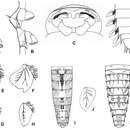Description
provided by Zookeys
Medium to large Heptageniidae (up to 20 mm) with contrasting color patterns.
Head broad and thickened anteriorly (Figs 2, 5, 8); labrum (Figs 16–17) small, wider than long, without conspicuous median incision; mandibles (Figs 18–19) with outer margin covered with numerous thin setae, outer and inner incisors subequal in length, outer one saw-like on both sides, inner one trifid, left mandible with tuft of setae above mola; maxillae with 3-segmented palp, ventral surface of galea-lacinia covered with numerous long setae (Fig. 25), which appear entire in optical microscope, but are slightly feathered in SEM, crown of the galea-lacinia with 20–25 comb-shape setae, median ones bearing 12–17 teeth (Fig. 26), distal dentisetae bifid and fimbriate, as the proximal one (Figs 23–24); hypopharynx with robust lingua and well developed superlinguae bend backwards (Figs 27–28); labium with rhomboid glossae (Figs 20–22), paraglossae regularly curved, apex not bend backwards and moderately expended laterally.
Thorax with pronotum slightly to greatly enlarged laterally; supracoxal spurs acute and well developed especially on mid- and hindlegs; femora rather similar between the three pairs of legs, row of stout and pointed bristles on inner and outer margins, no thin setae present; outer margin of fore tibia with few thin setae on proximal fourth, mid tibia with a row of thin setae on outer margin almost to tarsi, hind tibia (Figs 30, 32, 34) with two rows of thin setae, one on the outer margin, one in submarginal position, spine-like bristles absent or present.
Abdomen with posterolateral projection generally greatly enlarged from segment III to VII or VIII (Figs 3, 6, 9); posterior margin of tergites (Figs 35–37) with large and pointed teeth, microdenticles present and generally numerous; all gills asymmetrical (Figs 38–49), gills I–VI with plate-like and extremely developed fibrillose parts, gill VII only plate-like; terminal filament well developed, cerci whitish with more or less enlarged brown bands; segments with whorls of stout and pointed setae.
- bibliographic citation
- Sartori M (2014) The species of Thalerosphyrus Eaton, 1881 (Insecta, Ephemeroptera, Heptageniidae, Ecdyonurinae) in Java and Sumatra, with some comments on the diversity of the genus in the Oriental Realm ZooKeys 420: 19–39
- author
- Michel Sartori
Distribution
provided by Zookeys
The genus Thalerosphyrus is endemic to the Oriental Realm. It is known from India, through Southeast Asia (Thailand, Vietnam, West Malaysia), up to Sumbawa in the Sunda Islands (see below), suggesting, as for Rhithrogena (Sartori 2014d), that the Wallace line is not a barrier to the dispersal of some Ephemeroptera. The genus is however not currently reported from Sulawesi (Edmunds and Polhemus 1990). According to Braasch (2011), Thalerosphyrus is also not recorded from the Philippines, and its presence on the island of Borneo is only based on few data and no named species are known (Braasch 2011); in the MZL collections is a single nymph (Sabah, Mesilau River, 8 km north of Kundessan, 2100 m, 1.VIII.1985, J.T. & D.A. Polhemus leg) which is clearly related to Thalerosphyrus lamuriensis, but complementary material is needed before any definitive answer can be found. In the MZL collections is also deposited a single nymph from Nepal (Nawakot & Sindhu Districts, Patibhanjyang Village, elev. ca 6000’, 10.IX.1968, C. Wiens leg) which expands the distribution of the genus to the Himalaya.
- bibliographic citation
- Sartori M (2014) The species of Thalerosphyrus Eaton, 1881 (Insecta, Ephemeroptera, Heptageniidae, Ecdyonurinae) in Java and Sumatra, with some comments on the diversity of the genus in the Oriental Realm ZooKeys 420: 19–39
- author
- Michel Sartori

